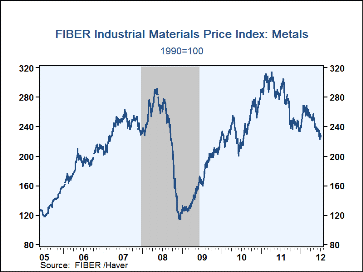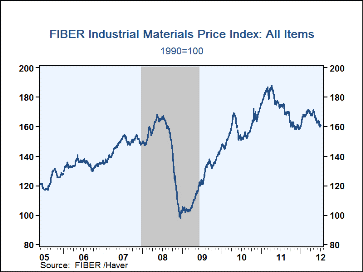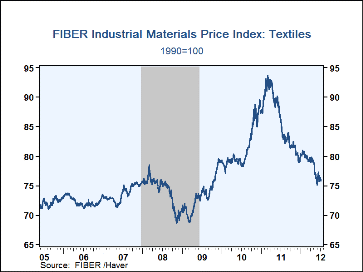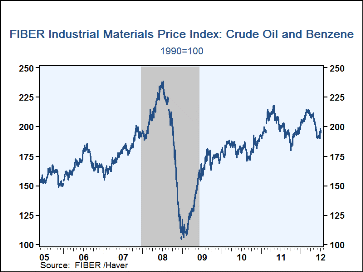 Global| Jul 11 2012
Global| Jul 11 2012FIBER: Industrial Commodity Prices Remain Weak
by:Tom Moeller
|in:Economy in Brief
Summary
Talk of global recession continues to pressure commodity prices downward. At 160.8, the latest price index from the Foundation for International Business and Economic Research (FIBER) was down 6.3% from its recent high and off 7.5% [...]
Talk of global recession continues to pressure commodity prices downward. At 160.8, the latest price index from the Foundation for International Business and Economic Research (FIBER) was down 6.3% from its recent high and off 7.5% from one year ago. During the last ten years there has been a 44% correlation between the three-month change in prices and the change in factory sector industrial production.
 In the metals group, prices have fallen 22.6% y/y led lower by
aluminum prices which are off one quarter y/y and by nearly one-third from
the 2011 peak. Copper scrap price declines also have been sizable and
steel scrap prices have given up earlier strength. Textile prices
remain weak (-10.7% y/y) led by declines in cotton prices, which are down
nearly one-half y/y and by two-thirds from the 2011 peak.
In the metals group, prices have fallen 22.6% y/y led lower by
aluminum prices which are off one quarter y/y and by nearly one-third from
the 2011 peak. Copper scrap price declines also have been sizable and
steel scrap prices have given up earlier strength. Textile prices
remain weak (-10.7% y/y) led by declines in cotton prices, which are down
nearly one-half y/y and by two-thirds from the 2011 peak.
Though they recently have bounced up a bit, lower crude oil prices (-9.6% y/y) have added to the weakness in the overall pricing environment. Prices for the petro-chemical benzene have strengthened considerably. In the miscellaneous group, prices have given up earlier strength. Lumber & plywood prices have fallen 6.2% since May while natural rubber prices also have fallen with lessened strength in global motor vehicle sales.
Commodity price data can be found in Haver's DAILY, WEEKLY, USECON and CMDTY databases.
Monetary Policy, Money and Inflation from the Federal Reserve Bank of San Francisco is available here.
| FIBER Industrial Materials Price Index (1990=100) | 07/10/12 | Y/Y % | 2011 | 2010 | 2009 |
|---|---|---|---|---|---|
| All Items | 160.8 | -7.5 | 172.9 | 157.7 | 121.4 |
| Textiles | 76.0 | -10.7 | 86.1 | 81.2 | 73.3 |
| Cotton (cents per pound) | 65.2 | -45.3 | 132.6 | 87.8 | 52.2 |
| Metals | 225.7 | -22.6 | 278.5 | 239.9 | 167.9 |
| Aluminum ($ per metric ton) | 1,876.0 | -23.5 | 2,400 | 2,172 | 1,662 |
| Copper Scrap (cents per pound) | 341.0 | -21.3 | 400.1 | 326.5 | 195.2 |
| Steel Scrap ($ per ton) | 347.7 | -16.6 | 412.4 | 325.7 | 203.4 |
| Crude Oil & Benzene | 196.7 | -1.2 | 199.3 | 182.0 | 150.9 |
| Crude Oil (WTI, $ per Barrel) | 86.0 | -9.6 | 95.1 | 79.5 | 61.4 |
| Miscellaneous | 203.8 | 8.6 | 190.5 | 178.8 | 127.6 |
| Framing Lumber ($ per 1000 board ft.) | 316 | 18.8 | 273 | 282 | 221 |
| Natural Rubber (cents per pound) | 207.7 | -4.3 | 261.8 | 181.8 | 83.0 |
Tom Moeller
AuthorMore in Author Profile »Prior to joining Haver Analytics in 2000, Mr. Moeller worked as the Economist at Chancellor Capital Management from 1985 to 1999. There, he developed comprehensive economic forecasts and interpreted economic data for equity and fixed income portfolio managers. Also at Chancellor, Mr. Moeller worked as an equity analyst and was responsible for researching and rating companies in the economically sensitive automobile and housing industries for investment in Chancellor’s equity portfolio. Prior to joining Chancellor, Mr. Moeller was an Economist at Citibank from 1979 to 1984. He also analyzed pricing behavior in the metals industry for the Council on Wage and Price Stability in Washington, D.C. In 1999, Mr. Moeller received the award for most accurate forecast from the Forecasters' Club of New York. From 1990 to 1992 he was President of the New York Association for Business Economists. Mr. Moeller earned an M.B.A. in Finance from Fordham University, where he graduated in 1987. He holds a Bachelor of Arts in Economics from George Washington University.










